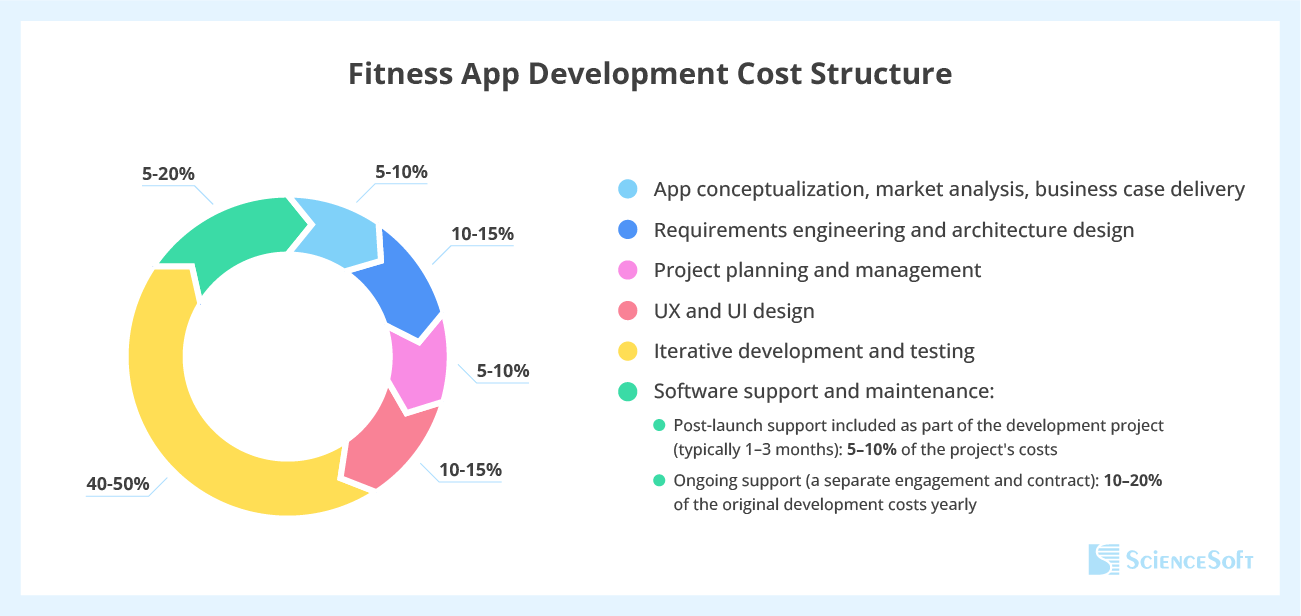Ultimate Guide to Fitness App Development Costs
With 20 years of hands-on experience in creating healthcare and wellness apps, ScienceSoft offers insights into the major fitness app development cost factors and ROI. We also share practical tips on how to reduce the development budget and pick the optimal sourcing and pricing models.
Fitness App Development Costs in Brief
The cost of developing a fitness app can range from $50,000 for a minimum viable product (MVP) and up to $600,000 for a full-featured product. Below are the key factors influencing the final cost:
- The app's functional complexity, including the number of integrations with other software or devices.
- UX and UI design: an app with a custom UI design tailored to your brand image and unique app features requires more design work, which influences overall costs.
- Development method (native, hybrid, cross-platform): building two native apps for iOS and Android tends to be more expensive as it requires separate development efforts for each platform.
- Development type (custom, low-code, platform-based): developing a custom app from scratch is more expensive.
- Sourcing model (in-house, partially or fully outsourced development): each model has its own cost drivers; as a rule, hiring an in-house development team is more expensive.
- Pricing model (in case of outsourcing): the efficiency of different pricing models would depend on your particular project’s complexity, level of certainty in the requirements, risk tolerance, and budget constraints.
- The involved team (hourly rates for different roles considering their seniority).
The fitness app's potential ROI exceeds 230% and depends on software capabilities, the chosen marketing and pricing tactics, market competition, user acquisition costs, and ongoing maintenance and support expenses.
Fitness App Features as a Major Cost Driver
The planned functionality will drive your fitness app development costs the most. We have grouped the features into basic, standard, and advanced brackets for an easy comparison.
Basic
$50,000–$100,000
- Manual logging and tracking of physical activity, mood, and lifestyle.
- GPS tracking.
- Calorie intake calculation.
- A premade collection of training and educational resources.
- Push notifications and reminders.
Standard
$200,000–$300,000
Basic features, plus:
- Tailored workout and nutrition plans based on each user’s age, physical condition, lifestyle, preferences, fitness goals, etc.
- Personalized goal setting and progress tracking.
- Gamification elements.
Advanced
Up to $600,000
Basic and standard features, plus:
- One-on-one video sessions with coaches and nutritionists.
- Live streaming of individual and group workout sessions.
- AI chatbots providing personalized recommendations and virtual coaching.
- AR and VR features.
Cost Structure Overview for Fitness App Development
A fitness app development plan largely determines the project budget and investment distribution throughout the process. The percentages below reflect the relative impact of each development step and may vary based on project specifics.

How to Reduce Fitness App Development Costs
Below, ScienceSoft’s experts offer insights on how to make a fitness app while minimizing your development expenses.
Start with an MVP
Prioritize the development of core functionalities (e.g., workout logging and tracking, progress visualization) and postpone non-essential features for future updates.
Invest in discovery to save on development
Begin with comprehensive requirements engineering to minimize the risk of scope creep and costly changes during development. Invest in market analysis to define your unique selling proposition (USP), the standout feature crucial for an MVP.
Use UI prototypes
Employ rapid prototyping tools like InVision or Figma to create interactive prototypes and quickly validate UI design concepts before investing in their execution.
Involve your QA and development teams at the earliest app design stages to ensure that the requirements are clear, feasible, and testable. Prioritize modular testing and API-level validation for early bug detection and shorter, more efficient development cycles.
Build reusable app modules
Choose component-based architectures such as microservices to develop modular, reusable code components. This approach accelerates feature rollouts with minimal disruption to software operation. It also simplifies software evolution as the app is made up of loosely coupled modules.
Opt for ready-made components
Use proven open-source and off-the-shelf components and frameworks instead of building custom code from scratch. By utilizing readily available components like APIs, UI elements, and AI models, you save the developers’ time and effort.
Consider low-code development
Low-code platforms (Microsoft Power Apps, OutSystems, Mendix) offer visual drag-and-drop modules to simplify app development, making it up to 4x cheaper and 10x faster compared to conventional coding.
Use test automation
When feasible, utilize automated testing frameworks to make QA processes more efficient, identify bugs earlier in the development cycle, and achieve up to a 20% reduction in the testing time and cost.
Set up continuous integration and deployment
Establish CI/CD pipelines to integrate, test, and deploy new features within 2 to 3 hours. Automation streamlines development workflows, reduces manual overhead, and expedites time-to-market, resulting in up to 78% reduced development costs.
Choosing the Right Sourcing Model for Your Fitness App Initiative
Fitness App Development Pricing Models
Fixed price
Under this model, the project scope, deliverables, and costs are agreed upon from the start, providing budget clarity and predictability. However, changes to the project scope during development are likely to be problematic and costly.
Best for:
- One-time consulting services (e.g., feasibility study, requirements engineering).
- Proof of concept (PoC) delivery for highly innovative fitness apps.
- Linear development of small-scale fitness apps that have a clear, well-documented SRS and a fixed budget.
Time & materials
Under this model, you are charged based on the actual time and effort expended by the development team in the past month. T&M offers greater flexibility to changes in project scope or requirements, as the client pays only for the work done.
Best for:
- Agile development of medium and large-scale fitness apps whose requirements may change based on user and stakeholder feedback.
- Startups who are developing an MVP before securing the investment for a full app version.
Sample Fitness App Development Cost Estimate
|
As an example, let's take Agile development of a cross-platform workout app with a standard package of functionalities.
|
|
The rough estimate for this project will be $250,000. To learn more about cost estimation methods in software development, check out our dedicated guide.
*The estimate provided is not ScienceSoft's official pricing for fitness software development. We calculate the cost of each project individually, based on our clients' specific situations and needs.
Fitness App Development ROI
Average development ROI: 230%+, depending on your app's capabilities and specifics, marketing and pricing strategies, competition in the market, user acquisition costs, and ongoing maintenance and support expenses.
The payback period typically ranges from 6 months to 3 years, depending on your app's success in attracting users, generating revenue, and ongoing operational costs.
About ScienceSoft
Based in McKinney, Texas, ScienceSoft is a trusted global IT consulting and software development company. Since 2005 in mobile development, we excel in creating intuitive and engaging fitness apps that resonate with users' needs. In our projects, we rely on robust quality management and security management systems backed by ISO 9001 and ISO 27001 certificates.




